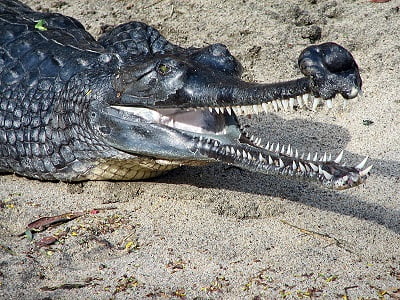Gharials (Gavialis Gangeticus)
Context:
Recently, the Department of Punjab Forest and Wildlife Preservation, in collaboration with the World-Wide Fund for Nature-India (WWF-India) has released a lot of 24 gharials (Gavialis Gangeticus) into the Beas Conservation Reserve.
About Gharials:
- The gharial also known as the gavial or the fish-eating crocodile,
- It is a crocodilian in the family Gavialidae and among the longest of all living crocodilians.
- Adult males have a distinct boss at the end of the snout, which resembles an earthenware pot known as a ghara, hence the name “gharial”.
- The gharial is well adapted to catching fish because of its long, thin snout and 110 sharp, interlocking teeth.
- Habitats include: Fresh waters of the northern India – Chambal river, Ghagra, Gandak river and the Sone river (Bihar).
- The gharial probably evolved in the northern Indian subcontinent.
- Fossil gharial remains were excavated in Pliocene deposits in the Sivalik Hills and the Narmada River valley. It currently inhabits rivers in the plains of the northern part of the Indian subcontinent.
- It is the most thoroughly aquatic crocodilian, and leaves the water only for basking and building nests on moist sandbanks.
- The wild gharial population has declined drastically since the 1930s, and is limited to only 2% of its historical range today.
- Conservation programmes initiated in India and Nepal focused on reintroducing captive-bred gharials since the early 1980s.
- Loss of habitat because of sand mining and conversion to agriculture, depletion of fish resources and detrimental fishing methods continue to threaten the population.
- It has been listed as critically endangered on the IUCN Red List since 2007.
- The oldest known depictions of the gharial are about 4,000 years old and were found in the Indus Valley.
- Hindus regard it as the vehicle of the river deity Gaṅgā. Local people living near rivers attributed mystical and healing powers to the gharial, and used some of its body parts as ingredients of indigenous medicine.
Status of Gharials:
- India has three species of Crocodilians namely:
- Gharial: IUCN Red List- Critically Endangered
- Mugger crocodile: IUCN- Vulnerable.
- Saltwater crocodile: IUCN- Least Concern.
- All the three are listed on Appendix I of CITES and Schedule I of the Wild Life (Protection) Act, 1972.
- However, Saltwater Crocodile populations of Australia, Indonesia and Papua New Guinea are included in Appendix II of CITES.
Beas Conservation Reserve
- It is a 185-kilometre stretch of the Beas River located primarily in the north-west of the State of Punjab.
- The Reserve also hosts the only known population in India of the endangered Indus River Dolphin (Platanista gangetica minor).
- In 2017, a programme was initiated to re-introduce the critically endangered gharial (Gavialis gangeticus) with 47 individuals released into the River 30 years after their disappearance.
Beas River
- It originates near the Rohtang Pass, at a height of 4,062 m above sea level, on the southern end of the Pir Panjal Range, close to the source of the Ravi. It is a tributary of the Indus river.
- It meets the Satluj river at Harike in Punjab. It is a comparatively small river which is only 460 km long but lies entirely within the Indian territory.
- It forms a gorge at Kati and Largi in the Dhauladhar range.
- The major tributaries of the Beas River are Bain, Banganga, Luni and Uhal, along with Banner, Chakki, Gaj, Harla, Mamuni, Parvati, Patlikuhlal, Sainj, Suketi and Tirthan.
What is IUCN?
The IUCN is a global union composed of both government as well as civil society organisations. With more than 1400 organisations as its members, the IUCN is an international authority on the status of the natural world.
- It works in the domain of sustainable development and also recommends measures to tackle the depletion of resources.
- It works to conserve the various species of flora and fauna.
- Its members include States, non-governmental organizations, indigenous peoples’ organisations, experts, government agencies, etc.
- Established in 1948, the IUCN has the tools and knowledge repository to help the world conserve nature and ensure sustainable development.
- When it was first set up in Fontainebleau (France), it was the first international environmental union. Its objective was to promote international cooperation and provide scientific knowledge and tools to aid conservation action.
- It established the IUCN Red List of Threatened Species in 1964.
- It also played a huge role in the formation of major international conventions such as the Ramsar Convention on Wetlands, the Convention on International Trade in Endangered Species, the World Heritage Convention and the Convention on Biological Diversity.
- In 1980, partnering with the UNEP and the World Wildlife Fund (WWF), the IUCN published the World Conservation Strategy, a document which helped define the concept of ‘sustainable development’ and shaped the global conservation and sustainable development agenda.
- In 1992, in light of the growing environmental concerns, the United Nations granted official observer status to the IUCN.
- Currently, the IUCN is the biggest and most diverse environmental network.
Source: Indian Express
You can find many articles on ENVIRONMENT (part of GS III) in our website. Go through these articles share with your friends and post your views in comment section.


